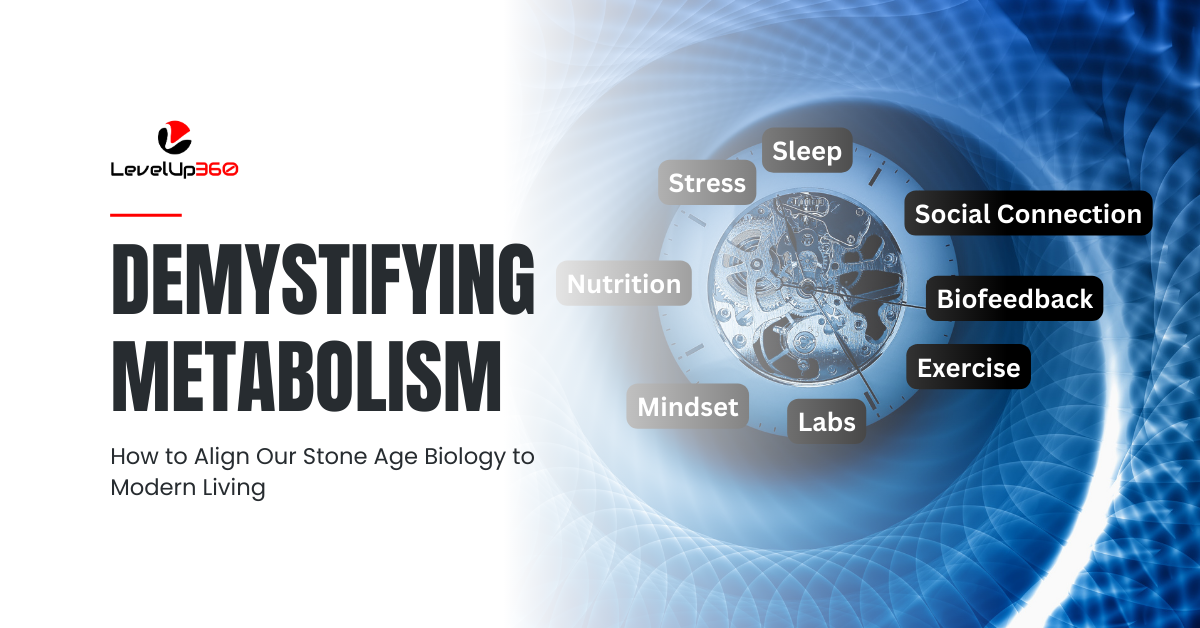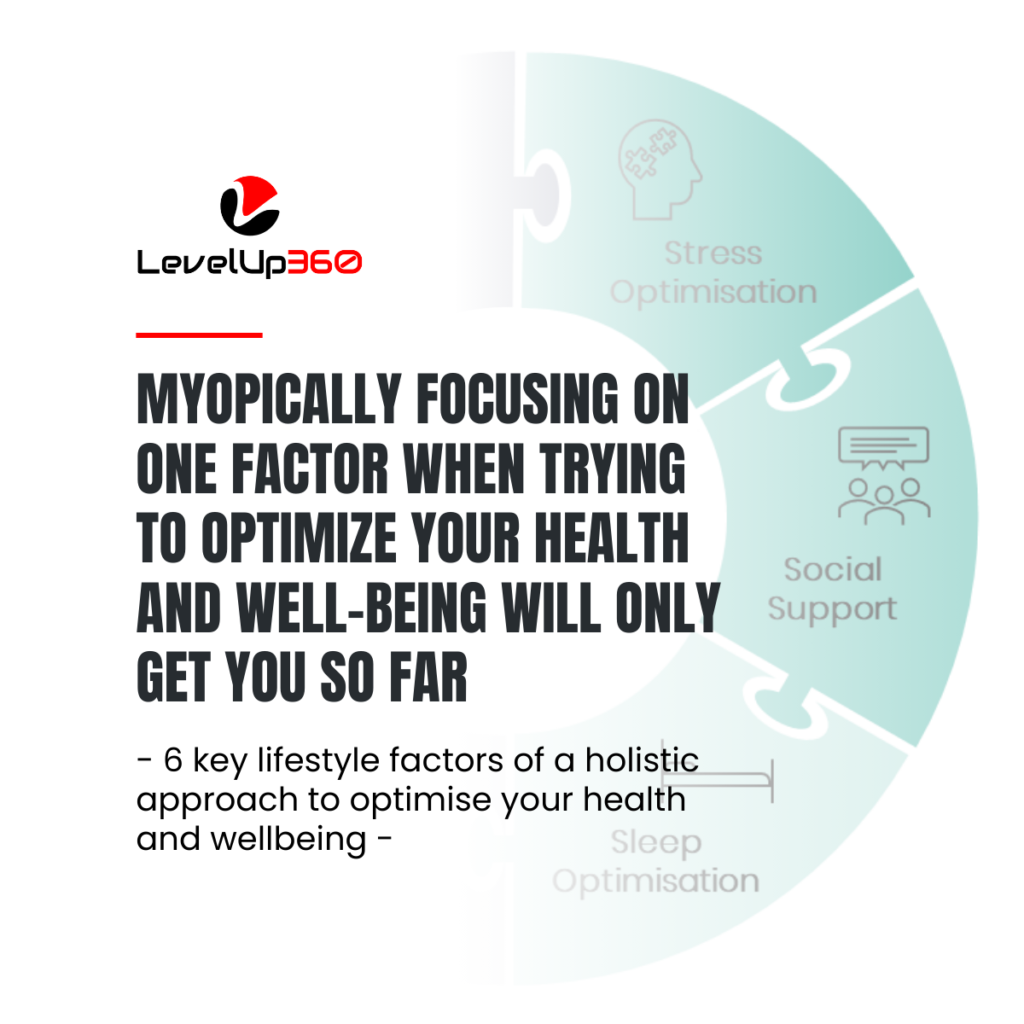
Demystifying Metabolism: How to Align Our Stone Age Biology to Modern Living
Metabolism is one of the most vital yet misunderstood aspects of our biology. It is a word that gets thrown around often, yet few truly understand this intricate biological process that is so vital to our health and fitness goals. We’ve all heard stories of the friend with the “slow metabolism” who struggles to lose weight or the envy-inducing family member with the “fast metabolism” who stays slim no matter what they eat.
But is metabolism fixed and beyond our control? Not exactly.
Genetics do play a role in influencing your metabolic rate but genes aren’t the whole picture. While complex, metabolism can be influenced by the lifestyle choices we make each day.
Understanding how our metabolism adapts and evolves gives us the power to work with, not against, our body’s natural energy regulation. In this article, we’ll demystify metabolism – defining what it is, looking at it through an evolutionary lens, and connecting the science to real-world examples. Let’s dive in!
Genetics do play a role in influencing your metabolic rate but genes aren't the whole picture. While complex, metabolism can be influenced by the lifestyle choices we make each day
What is Metabolism?
Metabolism refers to all the chemical reactions in our bodies that sustain life and function. It is the process that converts the food we eat into cellular fuel, powering everything from muscle contractions to hormone synthesis, to brain function.
More than a straightforward biological process, metabolism is a delicate and complex dance of energy expenditure and nutrient utilization that dynamically responds and adapts to our diet, lifestyle behaviours, and environment.
Metabolism consists of two key processes:
- Anabolism – this is the process of building larger, more complex molecules from smaller constituent units. For example, combining amino acids from consumed protein synthesises new muscle tissue and enzymes. Anabolism is an energy-consuming process.
- Catabolism – this process involves the breakdown of large complex molecules into smaller building blocks. For instance, the catabolic breakdown of stored triglycerides (body fat) into free fatty acids and glycerol to liberate energy. Catabolic processes release energy.
The yin and yang of anabolism and catabolism ensure that your body can grow, repair itself, and meet the demands you place on it on a daily basis.
At its very core, metabolism is all about regulating energy – carefully balancing intake from the food we eat with the utilization and expenditure to power our bodies. The food we consume can either be used immediately to provide energy for cellular processes or stored within the body as chemical energy for later use. This is much like saving up money in a bank account for use on a rainy day in the future.
When we talk about metabolism in the context of energy regulation, we’re referring to how our body adjusts to the energy we provide it. If we reduce our calorie intake, our metabolism doesn’t remain constant; it adapts.
But metabolism is not just about calories in – calories out, our hormones play a crucial role as regulators. The quantity and quality of the food we eat influence our hormones but our hormones also influence hunger, satiety, and energy levels.
Mitochondria, the powerhouses of the cell, also play a critical role in energy regulation. They can change their efficiency and number within our cells in response to energy availability. For example, during periods of energy restriction, mitochondria can become more efficient, extracting more energy from the nutrients we consume.
Viewing Metabolism Through an Evolutionary Lens

Today we live in a modern world where food is abundantly available, and physical activity is often optional and structured (in the form of purposeful exercise), rather than a constant survival necessity. This is a stark contrast to the conditions under which our metabolism originally evolved.
For instance, in an environment with constant food availability like today, our bodies tend to be more prone to storing excess consumed calories in the form of adipose fat tissue. This was once an advantageous adaptation to provide a reserve of energy during times of famine. However, in modern times, it often leads to unwanted weight gain and associated metabolic disorders.
Additionally, when we impose arbitrary modern fitness goals, diets, and routines on our bodies, they do not recognize these as inherently “healthy” or “fit”. Rather, the body simply responds to the signals of energy availability, stress, and nourishment that these modern regimens provide.
Often, when we suddenly and drastically reduce energy intake through extreme dieting, our metabolism will respond and react by slowing down overall energy expenditure and conserving energy. Hormone signals get disrupted, promoting increased fat storage while reducing muscle-building signals.
By appreciating some of the key differences between our modern lifestyles and the environments we evolved in, we can gain insight into why many modern health and fitness challenges arise. We can also better understand how to work with, not against, our intrinsic biology.
Think about how just 4 decades ago, childhood obesity was an exception – maybe one child in a classroom. Similarly, obesity in the general adult population was rare.
Our core metabolic processes have not dramatically evolved in just 40 years. Rather, our lifestyles and environments have changed rapidly. By appreciating the mismatch between our evolved biology and modern lifestyles, we can focus on making lifestyle adaptations to better support our metabolism.
Optimising Your Metabolism
The complexity of metabolism can seem daunting, however, you absolutely can take steps to optimise your metabolism in positive ways by focusing on a few key lifestyle factors:
1. Optimise Sleep, Nutrition, Exercise & Manage Stress: Following sustainable plans tailored to your needs and preferences supports overall metabolic health and homeostasis.
2. Cultivate Holistic Wellbeing: Nurturing positive mindset patterns, developing self-acceptance, fostering supportive social connections, and crafting a healthy relationship with food optimises the internal psychosocial conditions that influence metabolism.
3. Monitor Biomarkers and Biofeedback: Strategically using lab tests, metabolic panels, biomarkers, and biofeedback allows you to objectively understand what is going on inside your body. This data enables crafting personalised strategies that are responsive to your body’s specific needs, supporting optimal hormone balance and function for more effective goal achievement.
This holistic approach recognises the inherent complexity of the human metabolism. It emphasises the importance of addressing the physical, mental, emotional, and social aspects of health in tandem to positively influence metabolism.
When we pull on these different lifestyle levers in an integrated fashion, we can work synergistically with our intrinsic metabolic machinery. This provides the signals needed to effectively facilitate energy optimisation, fat loss, muscle building, fitness gains, and more based on your health objectives.
Real-World Applications

To understand how these principles apply in reality, let’s examine two archetypal scenarios that demonstrate common struggles with metabolism:
Case Study 1 - Maria’s Metabolism: Coping with Low Energy Availability
Maria had spent months aggressively restricting calories and doing BootCamp-style workouts several times a week in an attempt to slim down quickly for an upcoming beach vacation. Despite chronic hunger, exhaustion, irritability, and low libido, she doubled down on restrictive dieting to lose those last 10 pounds.
Unfortunately, Maria had hit a stubborn metabolic plateau and couldn’t shed those lingering pounds or the lower belly pooch. Blood tests revealed that Maria’s metabolism had slowed significantly.
Her thyroid hormones were suppressed, reproductive hormones had tanked, and cortisol was chronically elevated. Elevated ghrelin was driving ravenous hunger and cravings no matter how “clean” she tried to eat.
To revive Maria’s suppressed metabolism, the first step was to cut her exercise volume in half and increase her overall calorie intake back to maintenance level, with an emphasis on sufficient protein intake to protect lean muscle mass. Regular structured diet breaks were also implemented to give leptin and other key hormones a chance to normalize. On workout days, some higher glycaemic refeed meals were also incorporated to strategically boost calorie intake back up in a controlled manner. Lastly, we prioritized reducing stress and optimizing sleep.
With these changes, Maria’s hormone profile began to normalize and her metabolism was able to bounce back, restoring metabolic rate and efficient energy usage. She was then able to restart her fat loss journey from a much healthier place without having to fight against her body’s survival mechanisms.
Case Study 2 - James’ Metabolism: Addressing Metabolic Syndrome
James was struggling with rapid weight gain, constant brain fog, low energy, and early signs of insulin resistance despite no changes to his diet. His sedentary desk job and lack of activity outside work had led to mindless overeating and fast food several times a week to cope with work stress.
Testing revealed signs of metabolic syndrome – highly elevated fasting glucose, HbA1c, triglycerides, and blood pressure. While James’ leptin levels were very high, indicating plentiful fat stores, they were dysfunctional and not suppressing appetite due to cellular leptin resistance. To compensate, his pancreas was producing sky-high levels of insulin to force glucose into fat and muscle cells, indicating growing insulin resistance. Thyroid, testosterone and other key hormones were depressed as his weight continued to climb.
To counter and reverse James’ growing metabolic disturbances, a nutrient-dense reduced glycaemic load diet was used to stabilize blood sugar swings and lower insulin demands. Considering his very low activity levels, a moderate daily calorie deficit was required to promote weight loss. Regular structured refeed periods provided a metabolic reprieve while avoiding chronic restriction. Fast paced walking and weight training were incorporated to help restore glycaemic control through muscle gain and enhanced insulin sensitivity.
After several months of this metabolic recovery protocol, James’ body weight, hormone profile, biomarkers, and blood lipids all returned back to normal healthy ranges. His metabolism had adapted positively to the lifestyle changes.
Remember…
- Your metabolism is remarkably adaptable – it can change tempo and intensity in response to your body’s needs, much like a skilled orchestra dynamically responds to a conductor. The lifestyle choices you make each day function as the conductor’s baton, guiding this intricate biological symphony.
- You have more control over your metabolic function than you realise. By proactively optimising your sleep, diet, exercise regimen, and stress management, you can fine-tune your metabolic machinery for peak performance no matter your starting point.
- Your mindset and emotional health have tangible effects on the delicate hormonal signalling conductors that orchestrate your metabolism. Cultivating a positive self-image and an optimistic mindset can create a strong foundation.
- Your metabolism is unique as a fingerprint. Tracking biomarkers and subjective signals like energy, hunger, cravings, mood, sleep quality, and libido allows you to personalise your diet and lifestyle plans to fit your needs.
Each small daily choice and habit presents an opportunity to positively interact with your metabolism. Work with it, not against it. See it as your partner, not your adversary.
Whether your health and fitness goals involve accelerating fat loss, gaining strength and muscle, boosting energy, or enhancing well-being, remembering these metabolic principles will serve you well. Now is the time to put this knowledge into action.
Recommended reading
- 1
- 2
Recommended reading
- 1
- 2
Additional Resources
Feeling in control of your health
If you are interested in improving your health and wellness, check out other resources such as Our Blog, Free Resources and/or join our private Body-Mind Transformation Secrets Community on Facebook, and go on an even deeper dive with me to uncover how to succeed in your health and wellness goals.
You may also be interested in our Sleep Secrets Cheat Sheet. It is a great resource with strategies to fix and optimize your sleep which is crucial to succeeding in your health and wellness goals.
Resources
Pictures







